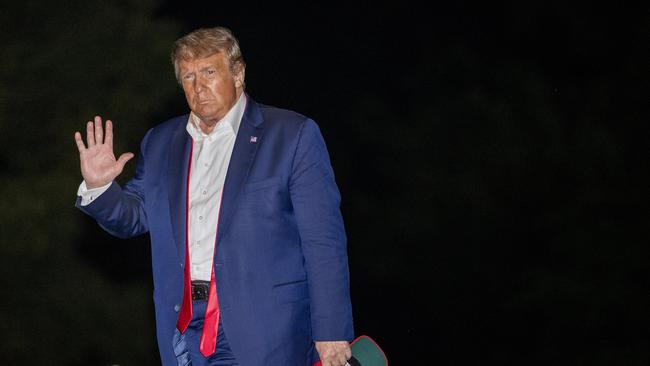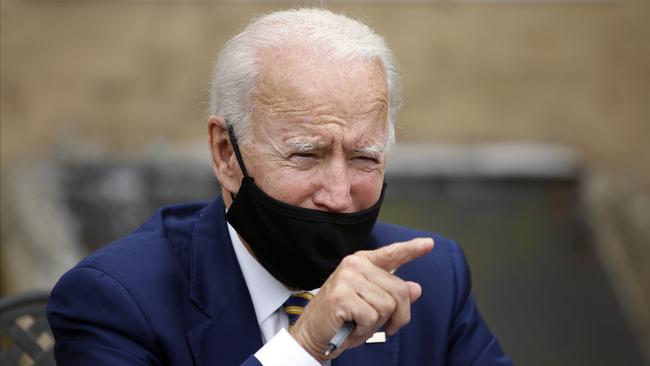Donald Trump down but not out
These are dark days for Donald Trump. His Democratic rival Joe Biden has a double-digit lead, Americans are miserable and election day is looming. Can he turn it around?

These are dark days for Donald Trump, but Republicans such as Lisa Dolezal remain adamant that the President will defeat Joe Biden in the November election.
Forget the polls that now show double-digit leads for Biden, says the 54-year-old human resources manager from Baltimore. Dolezal says the widespread criticism of Trump over his handling of the coronavirus pandemic and the racial tensions gripping US cities means nothing compared with the bread-and-butter issues that got him elected in the first place — jobs and the economy.
“For me and for my family it is the economy that counts,” the mother of two tells The Weekend Australian at her holiday home in Biden’s home state of Delaware. “Who can rebuild our economy better — a businessman like Trump or sleepy Joe Biden?
“Trump can be obnoxious and I don’t like his personality, but the economy was thriving before this pandemic and I think it will thrive again under his direction.”
Trump’s re-election prospects will depend heavily on the loyalty of voters such as Dolezal who helped send him to the White House in 2016 because she believed America needed “something different”.
But with a little more than four months to go before the election, Trump is struggling through the most difficult period of his presidency, beset with problems on multiple fronts and tumbling in the polls.
Even the betting market, where Trump had been a long-time favourite over Biden, has flipped this month, installing Biden as a hot 16-point favourite to make Trump a one-term president.
The shocking image of an exhausted, grim-faced Trump ambling across the White House lawn with his tie undone after returning late at night from his disastrous rally in Tulsa, Oklahoma, spoke volumes about the challenge he faces.

Polls show most Americans disapprove of Trump’s handling of the two greatest tests of his leadership this year — the coronavirus pandemic, which has claimed more than 120,000 American lives, and the mass protest movement over race and policing that has rocked the nation.
These come when the country is in acute economic pain, with more than 40 million out of work from the pandemic-induced economic shutdown.
Trump also has been forced to deny damaging claims in the tell-all book by former national security adviser John Bolton that Trump put his personal election prospects ahead of national security in his conduct of foreign policy, pandered to Chinese leader Xi Jinping and sought China’s help to win the election.
Now a fresh spike in COVID-19 cases across the country threatens Trump’s hopes of a much-needed economic rebound before the poll on November 3. Trump blames many of his woes on the hostile liberal US media, which is lapping up his recent misfortune. The left-wing CNN, for example, now has a semi-permanent screen headline, “America in Crisis”.
But Trump is having to deal with much more than spin. He faces a nation that, in many ways, is suffering psychological trauma on multiple fronts during this pandemic.
A new poll by the University of Chicago finds Americans are more unhappy today than they have been for almost 50 years, with only 14 per cent saying they are very happy. A Monmouth University poll finds a whopping 74 per cent of Americans believe the country is going in the wrong direction, up from 54 per cent three months ago.
Of course, this is not all Trump’s fault, but increasingly voters are blaming him for it.
New polls this week show Biden is surging ahead of Trump with double-digit leads in national polls and smaller but solid leads across the key battleground states of Michigan, Wisconsin, Florida and Pennsylvania.
A New York Times poll this week has Biden leading Trump by 14 points while a separate Reuters poll shows a 13-point lead and the bellwether poll — the RealClear Politics average of polls — shows Biden leading by just more than 10 points, 51 per cent to 40.9 per cent.
The New York Times poll shows Biden with a hefty 22-point lead among women, a 74-point lead among blacks, a 39-point lead among Hispanics and a 28-point lead among white college-educated voters. The only strong demographic for Trump is among white voters without college educations, where he enjoys a 19-point lead.
These polls have alarmed the Trump campaign, which is investing heavily in advertising to defend states that once were considered strongholds including Ohio, Texas, Iowa, North Carolina and even Arizona, which Trump visited this week.
Both campaigns caution that the gap between the two contenders will narrow sharply as the election gets closer.
Biden campaign manager Jen O’Malley Dillon says the double-digit leads for Biden are not sustainable and that Democrats will need to avoid “the bed-wetting that is going to come when those numbers narrow. This is going to be a very, very close race. Everyone needs to understand that.”
Trump supporters still hold out the hope of a repeat of the 2016 outcome where the polls wrongly predicted a win by Hillary Clinton. They point out that Clinton also had a comfortable lead over Trump at this stage of the race. Yet Trump’s attempt to break this current cycle by holding his first post-pandemic rally in Tulsa backfired when only 6200 people turned out in a 19,000-capacity stadium after his campaign had claimed that a million people sought tickets.
“Over-promising and underdelivering is the biggest mistake you can make in politics,” says Corey Lewandowski, Trump’s campaign manager for much of the 2016 race. “We won 38 primaries and caucuses under my stewardship — obviously all due to Donald Trump. But we never did something like this.”
The poor turnout, which reflects ongoing fears among even diehard Trump fans of catching the COVID-19, has cast doubt on how Trump conducts this campaign. The energy and spectacle of his rallies inside large, packed arenas was one of his most potent weapons in the 2016 campaign.
The Trump team has promised there will be more rallies, but probably in open-air or smaller venues, both of which the President reportedly opposes because they lack the atmosphere and impact of his 2016 rallies.
But Tulsa gave the clearest insight yet into how Trump plans to fight this campaign. He portrayed Biden as a feeble puppet of the left who would take the US down a path of cultural absolutism and lawlessness, ignoring America’s heritage and freedoms.
“If the Democrats gain power, then the rioters will be in charge and no one will be safe and no one will have control,” Trump said.
“Joe Biden is not the leader of his party. Joe Biden is a helpless puppet of the radical left. This cruel campaign of censorship and exclusion violates everything we hold dear as Americans. They want to demolish our heritage so they can impose their new oppressive regime in its place.”
Trump said a Biden presidency would see liberals regain control of the Supreme Court and threaten the right to life as well as the second amendment, undermining religious freedom while forcing socialist-style healthcare on all.
It was the same style of divisive, grievance-filled rhetoric that propelled Trump to victory in 2016, but it is unclear how much traction he will get with this similar message four years on.
Biden is an unimpressive campaigner, frequently stumbling over words and projecting a vision of yesterday’s America, a return to regular programming rather than a vision for the future.
But while there is an enthusiasm deficit for Biden with many voters, he is far more popular with both sides of politics than Clinton in 2016, making him a harder target for the President.
Trump’s efforts to portray Biden as a puppet of the left also poses a challenge given Biden’s adoption of a platform that rejects the key policy demands of liberal Democrats such as Medicare for all, free college tuition and hefty wealth taxes. Biden also has rejected the left’s calls to “defund the police” in the wake of the George Floyd protests, knowing that such extremism would likely cost him the election.
Yet Biden is still under pressure from the progressive wing of the party, with his former rival and democratic socialist Bernie Sanders pressuring the former vice- president to move further to the left during the campaign.
Trump has exploited this, linking Biden in his rally speech to the ideas of the so-called Squad of four young far-left congresswomen led by Alexandria Ocasio-Cortez.
“He (Trump) believes that he has to push Biden to the left, and I think that’s correct strategically,” Frank Luntz, the veteran Republican consultant and pollster told Politico.
“If Biden is seen as a centrist, he’ll have an advantage among swing voters who don’t want to support an extremist. But if he’s seen as left-wing ideologically or overtly partisan, swing voters will have a problem with him.”
Biden is ramping up his campaign for the first time, leaving his Delaware home to attend events in person and launching a $US15m ($21.7m) advertising campaign targeting the swing states.
Biden’s surge in the polls also has led to a surge in fundraising for the 77-year-old, who pulled in more than $US80m last month compared with $US74m raised by the Trump campaign, although Trump, 74, still has a much bigger campaign war chest.
Biden increasingly is focusing his attacks on Trump’s handling of the pandemic, with the Reuters poll showing a huge gap of 55 per cent disapproval among voters compared with only 40 per cent approval for the President’s management of the crisis.
He has accused Trump of being reckless towards the lives of Americans in playing down the importance of testing and in pushing for the economy to be reopened quickly while the virus is rampant.
But Democrats are divided on how visible Biden should be at this early stage of the campaign given Trump’s current problems and Biden’s penchant for gaffes when unscripted.
“Every day that’s not about Joe Biden is a day that Joe Biden wins,” says Pete Giangreco, a Democratic strategist who has worked on nine presidential campaigns. “That’s my view. Because if this thing’s a referendum on Trump, he’s going to lose.”
With more than four months to go Trump may be the clear underdog, but he is far from defeated.
Amid the gloom of the polls, there is one nugget that shines for both Trump and the Republicans. In each poll voters consistently say that Trump rather than Biden would be a better steward of the economic recovery after the pandemic, with the Reuters poll showing a preference of 43 per cent to 37 per cent for the President on the economy.
This is the argument put forward by Trump voters such as Dolezal and it may be Trump’s most powerful hand in the coming campaign — the claim that he helped build the strong economy until it was destroyed by the pandemic, so he is best qualified to rebuild it.
“We need a businessman to rebuild this economy and get people back to work,” says Dolezal. “We don’t want another politician like Biden.”
Trump also may get a boost from his claim to be the “law and order” president if the current wave of destruction of historical statues and monuments across the country continues unabated.
But his path to re-election is littered with far greater obstacles than statues.
The alarming spike in coronavirus cases in the US this week shows the pandemic is not going away, making it harder for the economy to rebound before November when voters make their choice.
As the polls show, Americans are as unhappy as they have been for five decades as they struggle with a crushed economy, health fears over the virus and ongoing racial turmoil.
Would they reward any president, especially one as divisive as Trump, with a second term under such circumstances? Maybe. But Trump is facing an uphill battle.
Cameron Stewart is also US contributor for Sky News Australia.

